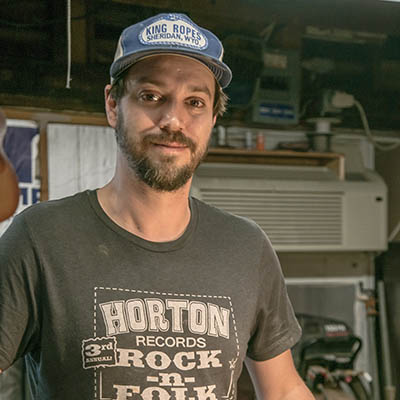A fish story
Seth Lee Jones is your local luthier
Seth Lee Jones at work
Greg Bollinger
You might’ve seen Seth Lee Jones playing at The Colony with Paul Benjaman, Jared Tyler, or Jacob Tovar. But Jones doesn’t just play—he also restores and repairs guitars, and it would seem he’s the perfect person to do so, having spent most of his life around the instrument.
I visited Jones in his workspace, where the magic and lore of his SLJ Guitars happens. I also met John Hnath, who was there working on a guitar. He took one of Jones’s guitar building classes a few years ago.
“I never left,” Hnath said.
Throughout my stay, the sounds of their work—sanding, polishing, chatting—filled the space.
Jones works from home, with a dedicated shop for guitar work out back. It’s clear he’s honored to live and work where his mentor Dixie Michell did until she passed away in 2015. Michell was a luthier who “wanted to improve sound as well as longevity,” he said, explaining her legacy of revolutionary advancements in guitar design. The house is filled with her old soda bottles and vintage décor. Guitars cover the walls of the front room. Jones showed me one of Michell’s guitars, marked in pearl with “The Dixie.”
Jones is partial to shaping the necks.
“It’s personal. When someone says a guitar ‘feels good,’ they’re not talking about the body,” he said. “They’re talking about the neck.”
To do this work by hand rather than by CNC (computer numerical control), a luthier must know how to carve; it must be an art.
“I became infatuated with woodwork,” he said. “Like people do with comic books.”
He prefers to use local materials, but it’s not always possible—his projects demand wood from all over. He loves black walnut and choke cherry, which comes from a small tree and must be found locally. People bring him the keys and wood from old pianos, as well as rosewood (now rare due to overuse) table runners—he’s even had koa wood shipped from Hawaii.
Jones’s first job was in furniture and building remodeling. At age 15, he moved to California to attend L.A. Valley College and Musicians Institute, going on to work with many master luthiers there, including John Carruthers, Fren Asken, and Mike Peters. He also attributes several of his tricks to furniture makers like Steve Walter, former director of Tulsa Wood Arts.
“When it comes to guitar building, many have this traditionalist idea—but the guitar as we know it isn’t even 200 years old,” Jones said. “I think a lot of people get in trouble by being too traditionalist. You can use other technology and facets of the same medium. Furniture makers are woodworkers. We’re doing the same stuff.”
Sixteen years after that first job, Jones still loves his work and intends to keep it that way.
 “I don’t want to squeeze the life out of it,” he said. “I want to play a few times a week and enjoy the work. I didn’t play when I worked on 80–90 guitars a week. I didn’t want to see strings after.”
“I don’t want to squeeze the life out of it,” he said. “I want to play a few times a week and enjoy the work. I didn’t play when I worked on 80–90 guitars a week. I didn’t want to see strings after.”
He credits musicians Jacob Tovar and Jared Tyler with his success as both a luthier and a musician in Tulsa: “They kept sending me work. Eventually Paul Benjaman heard about me. I was playing his guitar I fixed when he came to get it; he said ‘Man, what are you doing on Sunday?’” Now he regularly joins Benjaman for The Colony’s Sunday Nite Thing and has his own weekly gig there on Mondays.
Jones says the true trick to his craft is in putting a story behind the work.
“Stradivari is one of the most famous luthiers,” he said, “but not because he was the best. It’s the lore. A fish story. You can make beautiful instruments all day, but who wants to buy one without a story?” (Stradivari made more than 1,100 instruments, including the Viotti violin, first played in Paris in 1782 by Giovanni Battista Viotti. 650 of his instruments survive today, selling for up to $3.5 million.)
Jones and his guitars are expert storytellers. When I asked about his favorite neck style, he responded, “I’m partial to the Telecaster style. I’ve been playing one since I was a kid. I’ve always had a blondish one with a maple neck.”
He showed me his “old glove”—the one he can’t seem to part with—explaining how he once tried playing a sparkly new guitar, but it was “too shiny.” His old one is stained blue on the bottom from his jeans. He showed me where Tom Skinner and Jimmy Markham signed it, recalling one of his last interactions with Skinner: “Tom said, ‘Come and sit in on a Science Project before I die,’ so I went out on a Wednesday. I had to.” Skinner died shortly after.
When the shop suddenly grew quiet, I realized Hnath had finished the neck he’d been working on.
“It’s a whole different world in here,” I said, noticing a line of necks hanging on the wall.
“It’s a different world, all right,” he said, holding up his finished product.
“Time to sand those strings,” said Jones.
There were plenty more stories to tell; it wouldn’t be quiet much longer.


.jpg)
.jpg)
